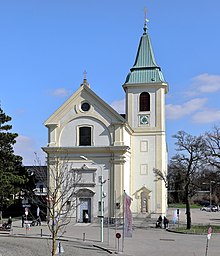User:Al Vadore/St. Joseph Church (Kahlenberg)
48°16′30″N 16°20′13″E / 48.274931°N 16.336839°E



The Church of St. Joseph is a Roman Catholic branch church of the parish Kahlenbergerdorf on the Kahlenberg in the 19th district of Döbling in Vienna. Before that, the former monastery church was the parish church of the settlement or former community of Josefsdorf on the Kahlenberg. It is dedicated to St. Joseph. The church is a listed building.
History[edit]
The origins of the church go back to the Camaldolese monastery, which was previously located on the Kahlenberg. The Camaldolese were settled on the Kahlenberg at the time of Ferdinand II and began building the Hermitage there in 1628/29. The foundation stone for the church was laid on August 10, 1629, most of which was completed by 1639. During the Second Turkish Siege of Vienna, the church was destroyed by the Turks on July 8, 1683. Although the fathers returned that same year, the reconstruction or new building of the church was not completed until 1734. In the course of the Josephine church reforms, the order was dissolved around 50 years later (1782). The court war councilor Leopold von Kriegl bought the church and most of the Hermitage buildings on April 14, 1783 for 28,550 guilders[1]. After he initially wanted to turn the church building into a dance hall, he later restored or rebuilt the church and obtained the elevation to a locality. On December 21, 1783, the re-inauguration took place by the provost of the Klosterneuburg Monastery Floridus.Cite error: The opening <ref> tag is malformed or has a bad name (see the help page).
It served first as a church, later as a parish church for the newly founded village of Josefsdorf. In 1809 it was damaged by Napoleonic troops. Presumably due to the small population, it was hardly used as a result and fell into disrepair over time. Even a renewed consecration in 1852 could not change that. It was not restored until the Resurrectionists took over the church in 1906. In memory of Jan Sobieski, who led the relief army against the Turkish besiegers from Kahlenberg in 1683, the church is still looked after by Polish priests, the Resurrectionists. Polish pilgrims also like to visit the church, including Pope John Paul II in September 1983. The northeastern elevation of the Kahlenberg, or the elevation of the Kahlenberg closest to the Danube, where the Leopold Chapel was built in 1693, has since been referred to as Leopoldsberg .
Building[edit]
The church is a baroque, aisleless church. The small side entrance is adorned with a statue of St. Joseph. The anteroom is entirely dedicated to the historical event of 1683, numerous drawings and pictures commemorate the historical battle. There are numerous baroque paintings in the interior of the church.
Sobieski Memorial Chapel[edit]
The Sobieski Memorial Chapel (formerly the 'Guardian Angel Chapel') is a historical memorial and the most valuable part of the Kahlenberg church. It is located in the southern part of St. Joseph's Church and adjoins the sacristy. Together with the sacristy, it formed today's 'Kahlenberger Museum', which is not open to the public.Cite error: The opening <ref> tag is malformed or has a bad name (see the help page).
The chapel was designed into the Sobieski Memorial Chapel (museum) by Jan Henryk Rosen, painter and professor at the Lviv Polytechnic in 1929/30, and was consecrated on May 28, 1931 in the presence of Federal President Wilhelm Miklas.[2]
Furnishing[edit]
High altar[edit]

In the center of the high altar there is a sculptural crucifixion group, which dates from the time it was used as a monastery church. On the side walls of the high altar there is a picture of St. Jerome at the top right, and a picture of John the Baptist on the left. Both pictures, works by the Bohemian painter Peter Johann Brandl, are a gift from Count Franz Anton von Sporck. An oil painting behind the crucifixion group, painted by Friedrich Schilcher in 1852, depicts serving angels with the tools of the Passion. Below is the Madonna from Kahlenberg, a copy of the picture of the name of the Virgin Mary, Pope Innocent XI, kept in the Santissimo Nome di Maria al Foro Traiano. donated to the church after the battle in 1683. Innocent also introduced the feast Mariae name for September 12th, with which Maria should be thanked for the supposed help in the battle.
Presbytery and side altars[edit]
Two other baroque paintings are along the long walls of the presbytery, on the right St. Leopold, on the left St. Romuald, the founder of the Camaldolese order. The paintings on the side altars are from the 18th century. Above the left side altar is a depiction of the Nativity, including a modern naive icon of Our Lady of Ludźmierz (Matka Boska Ludźmierska). The painting on the right side altar shows the baptism of Jesus. In a niche next to the left side altar hangs a copy of the miraculous image of the Black Madonna from the pilgrimage site of Częstochowa.Cite error: The opening <ref> tag is malformed or has a bad name (see the help page).
See alos[edit]
- Josefsdorf
- Kahlenberger Friedhof
Literature[edit]
- Christine Klusacek, Kurt Stimmer: Döbling. Vom Gürtel zu den Weinbergen. Compress-Verlag, Wien 1988, ISBN 3-900607-06-0, S. 167 f.
Weblinks[edit]
- ^ Rathkolb, Oliver (2020-10-12), "Zeithistorische Anmerkungen zur Geschichte der Musikschule der Stadt Wien 1938–1945.", Die Musikschule der Stadt Wien im Nationalsozialismus, Hollitzer, pp. 15–54, ISBN 978-3-99012-841-1, retrieved 2021-03-24
- ^ "ÖAW-Gschliefgraben-Symposium Proceedings vom 1. April 2009". ÖAW-Gschliefgraben-Symposium 2009. Wien: Verlag der Österreichischen Akademie der Wissenschaften. 2011. doi:10.1553/gde2010s1.
[[Category:Döbling]] [[Category:Baroque church buildings]] [[Category:Baroque architecture in Vienna]] [[Category:Churches in Vienna]]
